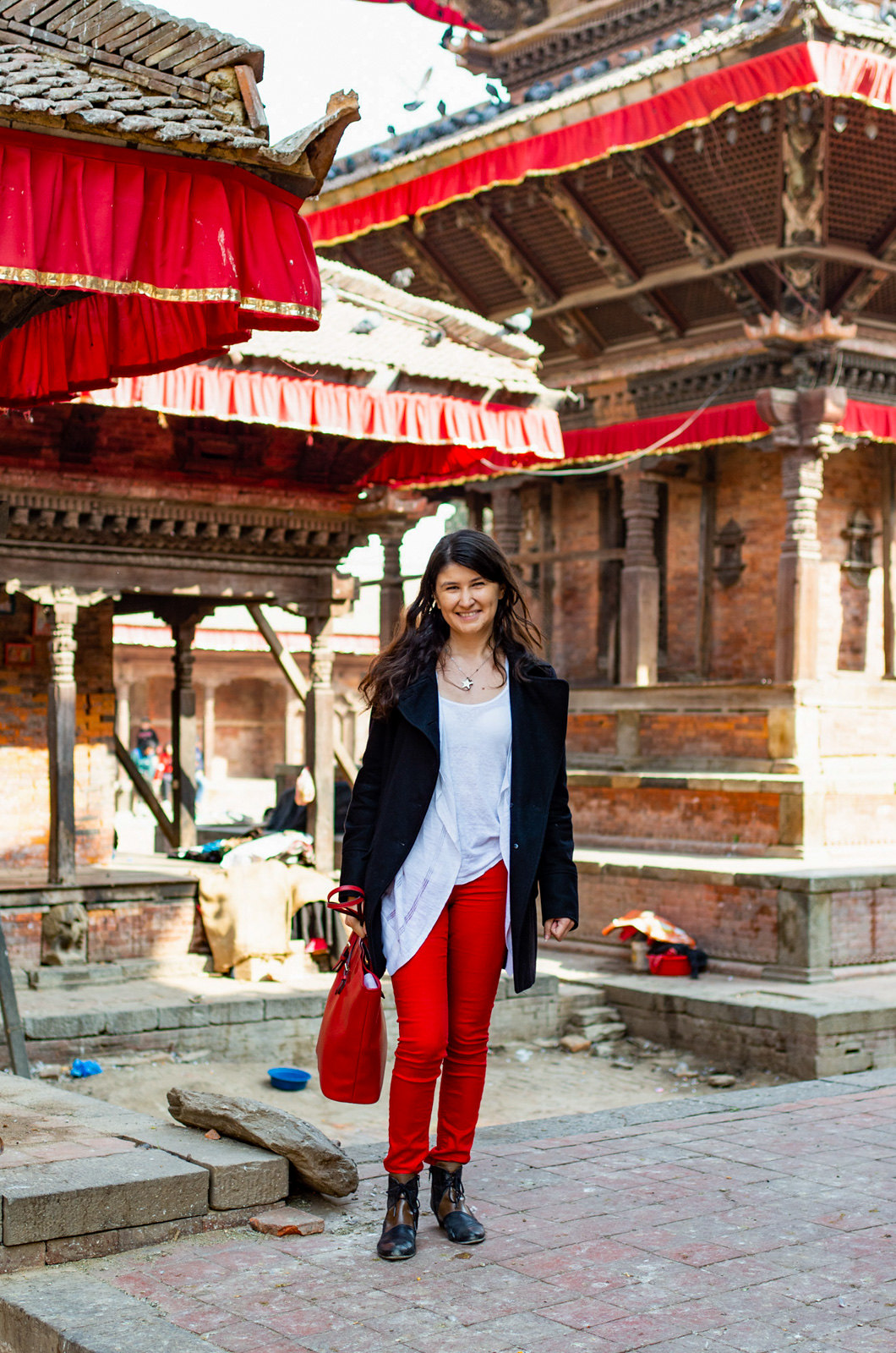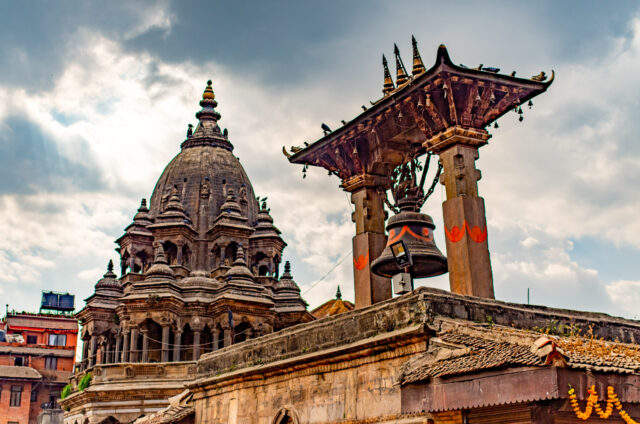If you only have one day in Kathmandu, you will have a very packed itinerary.
Here you will find the general post about visiting Kathmandu Valley and possible itineraries.
Day 1 highlights: Kathmandu Durbar Square, Garden of Dreams, Narayanhiti Palace, Swayambunath
While you can walk between some locations, on this day you will probably need a taxi.
The Kathmandu (Basantapur) Durbar square
Price: 1000 NPR for foreigners with a discount for SAARC nationals
There are kiosks at several spots for you to buy the ticket. Don’t believe any of the people, who will approach you and try to sell you one. Btw they will give you a map of the area at the kiosk, which is very useful for you to explore all corners.
The main North entrance is monitored, while others are less so. Some people suggest that you may be able to avoid fees by going from those entrances. However, keep in mind that you may be asked for a ticket anywhere around the square.

The square is located in the heart of city. You can easily walk here from Thamel and see some interesting temples on the way, like Kaathe Swyambhu Shree Gha Chaitya and Indra Chowk. Simply peak into little alleys and explore a bit. This way you will start getting acquainted with the colorful and beautiful atmosphere of the city.
Durbar square is not just a small square, as you may expect hearing the name. It’s quite a big place with a number of monuments to explore and discover, so allocate at least a couple of hours to it.
Durbar means palace or royal. This was the place, where kings lived and ruled from. There are three durbar squares in the valley (Kathmandu, Patan and Bhaktapur). Before the unification of Nepal, they were the three Newar kingdoms with their own kings. They were competing with each other, which resulted in amazing architecture.

Construction at the site of the Kathmandu Durbar Square began in the 3th century. However, most of the buildings you will see now are of 16th century. The square was significantly damaged during the 2015 earthquake and while some buildings were reconstructed, work is continuing to restore others.
The Hanuman Dhoka Palace Complex is the main site here. the Palace was damaged by the earthquake, but reconstruction was completed recently with the help from Chinese. The name of the palace comes from the statue of monkey god Hanuman located at the entrance. The complex is certainly beautiful with lovely courtyards.
The palace was the residence of Malla kings followed by the Shah dynasty, which ruled till 2006. You will find the latter’s photos and information about their history in the palace museum.
When we visited the Palace complex was still being reconstructed, so part of it was not accessible. However, we got the feeling of its former glory.
Don’t miss visiting the Kumari House – the house of a “virgin” “living goddess”. This tradition of choosing Kumari is still alive to this day, which is baffling. Hindus believe that she is a reincarnation of Goddess Teleju, while Buddhists – of Goddess Vajradevi. Either way, she is worshipped, while she serves, as Kumari.
Note: there are several Kumaris around Kathmandu Valley with Royal Kumari, who lives at the Kumari House, the most famous.
Kumari is chosen from Newar community through a religious ceremony. Little girls are tested and whichever of them is not frightened is chosen, as the reincarnation of the Goddess. Since that day, she lives in the Kumari House only getting out during festivals and religious ceremonies. Her feet should never touch the ground. This lasts until she is injured or starts menstruating (the idea is losing blood). Once that happens, she is again a mortal and goes back home, while the new Kumari takes over. This whole experience certainly affects Kumaris for life. This BBC video depicts the life of Kumaris.
You may be able to view Kumari from the upper window of the house during morning and late afternoon, but taking a photo is forbidden.
Nearby, you will find the 16th century Hindu Taleju Temple. The three storey pagoda style temple is only open once a year and non Hindus aren’t allowed to visit it. Nearby, Nasal Chawk is a famous square, where coronation of kings was taking place up until 2001.
You will also find a number of other temples, museums and monuments here, so do explore every nook and cranny. While here, you may even witness a festival or a religious ceremony. For instance, when we visited, there was some sort of an event with little girls dressed in traditional clothes.

Unfortunately, the square is not well maintained, as most places we visited around here. You will find garbage everywhere and tons of people trying to sell stuff.

Narayanhiti Palace
Price: 1000 NPR
You are not allowed to take any bags, cameras or mobile phones inside. You will have to leave everything in the locker outside. I kept a small purse with our passports, cards and money, as I never leave those anywhere. As a result of these rules, we have no photos taken there.
After the square, return to Thamel and visit the Narayanhiti Palace. I didn’t suggest to start with the palace, because it works only from 11 AM to 3 PM in winter and to 4 PM in summer. You can buy tix until 2 PM and 3 PM respectively. So your only option is to visit in the afternoon.
In its current form, the palace was constructed in 1963. Before that there were other structures at this location, which were demolished. The highlight is the Throne room with fancy golden throne and chandelier. You will also visit the reception room, meeting room, waiting room, etc. Another section of the palace is the living quarters of the royal family.
Walking around the palace, it feels like the place of the 70s, with old TV sets, old technology, etc. It is quite strange, given that the royal family lived here until the 2001 massacre.
You will actually see the room, where the massacre happened, with bullet holes on the walls. You probably have heard of the famous massacre. If you haven’t here is a short recap. The crown prince Dipendra killed his mother and father (the King and the Queen), his brother, sister and cousins, before committing suicide by shooting himself in the head. The massacre happened during the family dinner. The shooter was proclaimed king while he was in coma and died three days later.
No one knows the real reason of the shootings. There are several theories. The most commonly repeated one is that the crown prince was in love with a woman from the “lower class”, while his parents objected to their marriage. There are other conspiracy theories as well, but no one can say for sure.
Several years later, in 2006 monarchy was abolished and Nepal was declared a republic.
Garden of Dreams
Price: 200 NPR for foreigners with a discount for SAARC nationals
After visiting the palace, walk several minutes to the Garden of Dreams. you will definitely need to relax after the heavy history of the palace. The garden is very small and cute with an amphitheater, pools and pavilions. It was built in 1920.
After relaxing in the garden, head to the highlight of the day: The Swayambunath.
Swayambunath (Monkey Temple)
Price: 200 NPR for foreigners with a discount for SAARC nationals
Swayambunath is I guess my favourite place in Kathmandu. It stands on a hill and provides nice views of the city. We really loved spending time here, exploring the different corners, watching the monkeys play.

To get here from the city center, you will most probably have to take a taxi, unless you are ok walking about 35-45 minutes. This walk may not be as amazing, you may not have sidewalks oftentimes, but it’s a good way to see the spots, where tourists don’t venture. We took a taxi there and walked back to Thamel in the evening.
Once at the Temple area, I suggest to walk up from the side of Maha Manjushree Sarashwati Temple (the taxi dropped us off here) and then walk up to the Statue of Peace. These areas are lovely and worth exploring for sure. This will also provide less problematic climb, than the main stairs. Actually, we didn’t know about this way, the taxi driver took us there and we were very grateful, as we got to see these parts too. Afterwards, you can walk down from the main stairway. Or you can do vice versa, go up from the main entrance side and down – from the other side. You will have to overall climb 365 stairs (I read so, we didn’t really count them 😊).
The Buddhist temple is said to date back to the 5th century. This is a temple complex, with the main temple being far smaller than Boudhanath, but similarly has all-seeing eyes on all sides.

It is not called a monkey temple for nothing: There are hundreds of monkeys around. They hang out in groups. We threw a couple of bananas to them and it was fun watching them peel it and eat. They didn’t fight over food though, which was surprising 😊 Overall, these monkeys were far less aggressive and unpleasant than the ones we saw in other parts of Kathmandu. Maybe the locality affects their behavior 😊 We didn’t stay there at night, but I have heard monkeys fully take over at the end of the day, so be careful after dark.
After this long day, take a taxi or walk to Thamel and find one of the restaurants and cafes. Or just explore the area in the evening.
See the best suggested 2-day itinerary for visiting Kathmandu Valley.
See the best suggested 3-day itinerary for visiting Kathmandu Valley.
See the best suggested 4-day itinerary for visiting Kathmandu Valley.
See the best suggested 5-day itinerary for visiting Kathmandu Valley.



